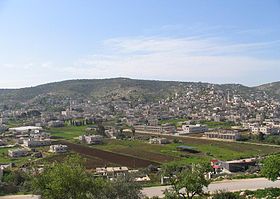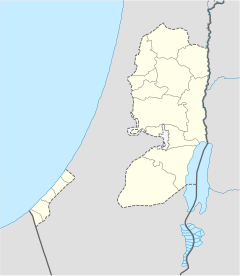Qabatiya
|
Qabatiyah قباطية |
||
 Panoramic view of Qabatiya |
||
| Administration : |
|
|
| Governorate : | Jenin | |
| Coordinates : | 32 ° 25 ' N , 35 ° 17' E | |
| Height : | 256 m | |
| Residents : | 19,197 (2007) | |
| Community type: | city | |
|
|
||
Qabatiya ( Arabic قباطية, DMG Qabāṭiyya , also Qabatia or Qabatiyah ) is a Palestinian city in northern West Jordan , 7 kilometers south of Jenin . According to the Palestinian Central Bureau of Statistics (PCBS), the city had a population of 19,197 at the 2007 census.
The total land area is 50547 dunam (50.5 km²) and is about 256 m above sea level. Qabatiya is famous for its olive groves , modern agriculture and limestone industry.
history
Remains have been found in Qabatiya from the times of the Old Persian Empire , Hellenism , the Early and Late Roman Empires , the Byzantine Empire, and from the early Muslim and Medieval Era, reported a Muslim traveler in the 12th century AD.
Ottoman era (1517-1920)
Qabatiya, like all regions in Palestine , was incorporated into the Ottoman Empire in 1517 . In the tax registers of 1596 it was part of the nahiya ("Subdistrict") of Jabal Sami, part of the larger sanjak of Nablus . It had a population of 89 households and 18 bachelors, all Muslim . Residents paid a fixed tax rate of 33.3% on agricultural products, including wheat, barley, summer crops, olive trees, goats and beehives, in addition to occasional income; A total of 14,920 akçe . Half of the proceeds went to the Tarabay Bey of Lajjun . In 1105 AH (1693 AD), ʿAbd al-Ghanī an-Nābulusī mentioned Qabatiya as "a village on the road from Nablus to Jenin".
In 1838, Edward Robinson found Qabatiya as a very large village surrounded by very extensive and beautiful olive groves . During 1850, Qabatiya was described as "surrounded by gardens, on the side of a rocky hill, grown and covered with olive trees".
In 1870 Victor Guérin described Qabatiya as “a garden with fig, olive and pomegranate trees planted with vegetables below the village. It was a large village divided into several areas under the jurisdiction of many different sheikhs ”. He also stated that “Kubataieh stands on a rocky hill, the sides of which are marked by numerous cisterns , some of which are partially filled and in poor condition, others are still used by the people. The latter are closed at the mouth by large round stones in the shape of a millstone - pierced in the middle. This second opening is itself closed by another stone, which is removed when the water is drawn. This system of closed wells and cisterns through a stone is a relic from ancient times . "
In 1882, the Palestine Exploration Fund 's Survey of Western Palestine described Qabatiya as a “large hillside stone village east of a small plain full of olives. It has a holy place in the south (Sheikh Theljy) and a good orange garden near the village. "
British era 1920-1948
In the 1922 Palestine Census conducted by the British Mandate Government, Qabatiya had 1,803 inhabitants, 1,799 of whom were Muslim and four Christians, all of whom were Orthodox. The number of inhabitants increased to 2,447, two Christians and the remaining Muslims, in a total of 551 houses according to the 1931 census.
By 1945 the population of Qabatiya, together with Kh. Tannin, grew to 3,670 inhabitants, all Muslims, with 50,547 dunams of land, according to an official land and population survey. 9,542 dunams were used for plantations and irrigable land, 21,464 dunams for grain. While 113 dunams were urbanized, 19,428 dunams were classified as “not cultivable”.
1948-1967 era
In the course of the war in Palestine and after the armistice agreements [1949], Qabatiya came under the rule of Jordan .
After 1967
Qabatiya has been under Israeli occupation since the Six Day War in 1967 . Since 1995 Qabatiya is administered by the Palestinian Authority (PA), in what is considered today Areas A and B is known. In Qabatiya there have been numerous confrontations with the Israeli occupation forces since 1967, with a great number of dead and injured in the population. About ten Qabatiya Palestinians were killed between October 2015 and July 2016 while carrying out attacks against Israelis. Clashes between Palestinians and Israeli forces occurred in July 2016 while a man accused of participating in an attack in Jerusalem demolished his house . The Israeli military reported that the military convoy that carried out the demolition was attacked by Molotov cocktails and fired by improvised artillery. Palestinian officials reported six Palestinians were wounded in the clash, with the Israeli military killing three Palestinians. Israel calls for the homes of attackers to be demolished as a deterrent to violence, while human rights groups and Palestinians condemn it as a form of collective punishment .
literature
- Barron, JB (Ed.): Palestine: Report and General Abstracts of the Census of 1922 . Government of Palestine, 1923 ( archive.org ).
- Avram S. Bornstein: Crossing the Green Line Between the West Bank and Israel . University of Pennsylvania Press, 2002, ISBN 0-8122-1793-4 ( Google book ).
- Claude Reignier Conder, Herbert Kitchener: The Survey of Western Palestine: Memoirs of the Topography, Orography, Hydrography and Archeology . tape 2 . Committee of the Palestine Exploration Fund , London 1882 ( archive.org ).
- Department of Statistics: Village Statistics, April, 1945 . Government of Palestine, 1945 ( org.il ).
- Victor Guérin: Description Géographique Historique et Archéologique de la Palestine . tape 2 : Samarie, part 1. L'Imprimerie Nationale, Paris 1874 (French, archive.org ).
- Sami Hadawi: Village Statistics of 1945: A Classification of Land and Area ownership in Palestine . Palestine Liberation Organization Research Center, 1970 ( palestineremembered.com ).
- Wolf-Dieter Hütteroth, Kamal Abdulfattah: Historical Geography of Palestine, Transjordan and Southern Syria in the Late 16th Century . Ed .: Board of Directors of the Franconian Geographical Society. Special volume 5. Erlangen Geographical Works, Erlangen 1977, ISBN 3-920405-41-2 ( Google book ).
- E. Mills (Ed.): Census of Palestine 1931. Population of Villages, Towns and Administrative Areas . Government of Palestine, Jerusalem 1932 ( archive.org [PDF]).
- Vere Monro: A summer ramble in Syria, with a Tartar trip from Aleppo to Stamboul . tape 1 . R. Bentley, London 1835 ( archive.org ). (Monro, 1835, Volume 1, p. 277 , cited in Robinson and Smith, Volume 3, p. 154 )
- Benny Morris: Righteous Victims: A History of the Zionist-Arab Conflict, 1881-1998 . Knopf Doubleday Publishing Group, 2011, ISBN 0-307-78805-9 ( Google book ).
- Edward Henry Palmer: The Survey of Western Palestine: Arabic and English Name Lists Collected During the Survey by Lieutenants Conder and Kitchener, RE Transliterated and Explained by EH Palmer . Committee of the Palestine Exploration Fund , 1881 ( archive.org ).
- Edward Robinson, Eli Smith: Biblical Researches in Palestine, Mount Sinai and Arabia Petraea: A Journal of Travels in the year 1838 . tape 3 . Crocker & Brewster, Boston 1841 ( archive.org ).
- Louis Félicien de Saulcy : Narrative of a journey round the Dead Sea, and in the Bible lands, in 1850 and 1851 . tape 1 , new edition. R. Bentley, London 1854 ( archive.org ).
- Adam Zertal: The Manasseh Hill Country Survey . tape 1 . BRILL, Boston 2004, ISBN 90-04-13756-4 ( Google book ).
Web links
- Welcome To Qabatiya - palestineremembered.com
- Survey of Western Palestine, Map 11 ( Memento from April 14, 2008 in the Internet Archive ), see also: Wikimedia Commons
- Population statistics ( Memento from November 15, 2011 in the Internet Archive )
Individual evidence
- ↑ 2007 Locality Population Statistics . Palestinian Central Bureau of Statistics
- ↑ Qabatiya - قباطية
- ↑ a b c Zertal, 2004, pp. 177–178
- ↑ Hütteroth and Abdulfattah, 1977, p. 127
- ^ Robinson and Smith, 1841, Volume 3, p. 154
- ↑ de Saulcy, 1854, Volume 1, p. 86
- ↑ Guérin, 1874, pp. 343-344
- ↑ Guérin, 1874, pp. 343-344 ; translated by Conder and Kitchener, 1882, SWP II, p. 156
- ^ Conder and Kitchener, 1882, SWP II, p. 156
- ^ Barron, 1923, Table IX, Sub-district of Jenin, p. 29
- ^ Barron, 1923, Table XV, p. 47
- ↑ Mills, 1932, p. 71
- ^ Department of Statistics, 1945, p. 16
- ^ Government of Palestine, Department of Statistics. Village Statistics, April, 1945. quoted in Hadawi, 1970, p. 55
- ^ Government of Palestine, Department of Statistics. Village Statistics, April, 1945. quoted in Hadawi, 1970, p. 99
- ^ Government of Palestine, Department of Statistics. Village Statistics, April, 1945. Quoted in Hadawi, 1970, p. 149
- ↑ Bornstein, 2002, p. 48
- ^ Palestinians struggle to recover from Qabatiya blockade , February 22, 2016
- ^ Morris, 2011, p. X
- ↑ 1995 Oslo Interim Agreement . Text of the Accord
- ↑ Clashes as Israel destroys Palestinian home over deadly attack (English) , AFP News Agency. 18th July 2016.


